Vít Růžička
Optimizing Methane Detection On Board Satellites: Speed, Accuracy, and Low-Power Solutions for Resource-Constrained Hardware
Jul 02, 2025Abstract:Methane is a potent greenhouse gas, and detecting its leaks early via hyperspectral satellite imagery can help mitigate climate change. Meanwhile, many existing missions operate in manual tasking regimes only, thus missing potential events of interest. To overcome slow downlink rates cost-effectively, onboard detection is a viable solution. However, traditional methane enhancement methods are too computationally demanding for resource-limited onboard hardware. This work accelerates methane detection by focusing on efficient, low-power algorithms. We test fast target detection methods (ACE, CEM) that have not been previously used for methane detection and propose a Mag1c-SAS - a significantly faster variant of the current state-of-the-art algorithm for methane detection: Mag1c. To explore their true detection potential, we integrate them with a machine learning model (U-Net, LinkNet). Our results identify two promising candidates (Mag1c-SAS and CEM), both acceptably accurate for the detection of strong plumes and computationally efficient enough for onboard deployment: one optimized more for accuracy, the other more for speed, achieving up to ~100x and ~230x faster computation than original Mag1c on resource-limited hardware. Additionally, we propose and evaluate three band selection strategies. One of them can outperform the method traditionally used in the field while using fewer channels, leading to even faster processing without compromising accuracy. This research lays the foundation for future advancements in onboard methane detection with minimal hardware requirements, improving timely data delivery. The produced code, data, and models are open-sourced and can be accessed from https://github.com/zaitra/methane-filters-benchmark.
HyperspectralViTs: General Hyperspectral Models for On-board Remote Sensing
Oct 24, 2024



Abstract:On-board processing of hyperspectral data with machine learning models would enable unprecedented amount of autonomy for a wide range of tasks, for example methane detection or mineral identification. This can enable early warning system and could allow new capabilities such as automated scheduling across constellations of satellites. Classical methods suffer from high false positive rates and previous deep learning models exhibit prohibitive computational requirements. We propose fast and accurate machine learning architectures which support end-to-end training with data of high spectral dimension without relying on hand-crafted products or spectral band compression preprocessing. We evaluate our models on two tasks related to hyperspectral data processing. With our proposed general architectures, we improve the F1 score of the previous methane detection state-of-the-art models by 27% on a newly created synthetic dataset and by 13% on the previously released large benchmark dataset. We also demonstrate that training models on the synthetic dataset improves performance of models finetuned on the dataset of real events by 6.9% in F1 score in contrast with training from scratch. On a newly created dataset for mineral identification, our models provide 3.5% improvement in the F1 score in contrast to the default versions of the models. With our proposed models we improve the inference speed by 85% in contrast to previous classical and deep learning approaches by removing the dependency on classically computed features. With our architecture, one capture from the EMIT sensor can be processed within 30 seconds on realistic proxy of the ION-SCV 004 satellite.
Fast model inference and training on-board of Satellites
Jul 17, 2023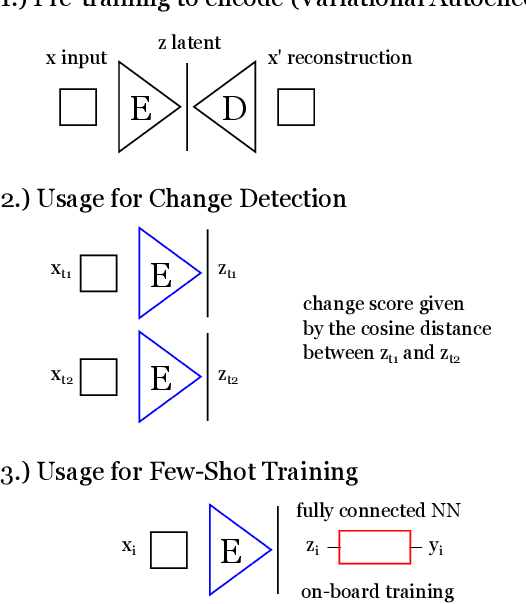
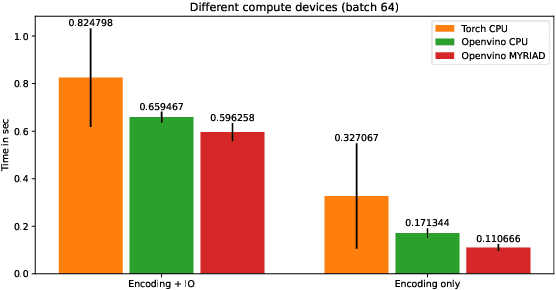
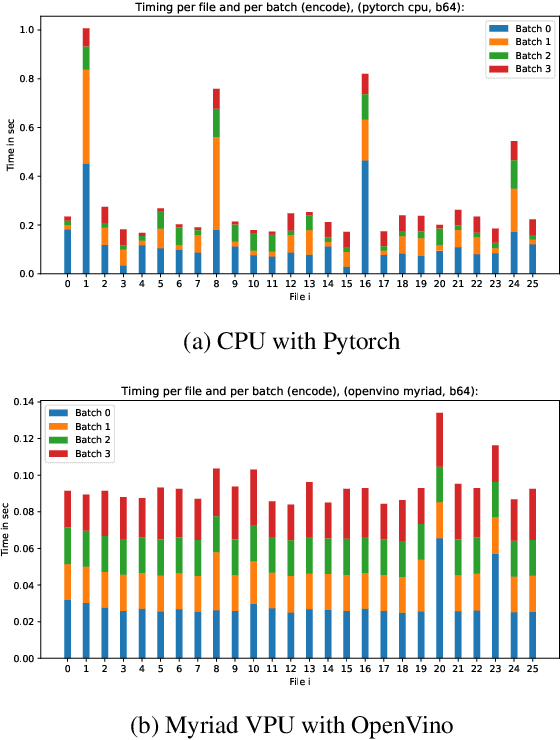
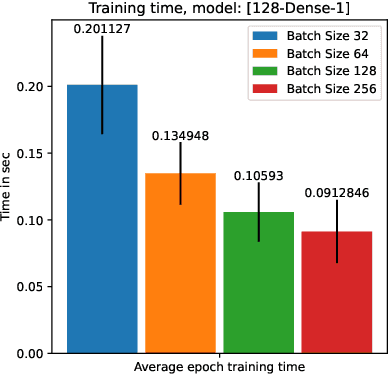
Abstract:Artificial intelligence onboard satellites has the potential to reduce data transmission requirements, enable real-time decision-making and collaboration within constellations. This study deploys a lightweight foundational model called RaVAEn on D-Orbit's ION SCV004 satellite. RaVAEn is a variational auto-encoder (VAE) that generates compressed latent vectors from small image tiles, enabling several downstream tasks. In this work we demonstrate the reliable use of RaVAEn onboard a satellite, achieving an encoding time of 0.110s for tiles of a 4.8x4.8 km$^2$ area. In addition, we showcase fast few-shot training onboard a satellite using the latent representation of data. We compare the deployment of the model on the on-board CPU and on the available Myriad vision processing unit (VPU) accelerator. To our knowledge, this work shows for the first time the deployment of a multi-task model on-board a CubeSat and the on-board training of a machine learning model.
Unsupervised Wildfire Change Detection based on Contrastive Learning
Nov 26, 2022



Abstract:The accurate characterization of the severity of the wildfire event strongly contributes to the characterization of the fuel conditions in fire-prone areas, and provides valuable information for disaster response. The aim of this study is to develop an autonomous system built on top of high-resolution multispectral satellite imagery, with an advanced deep learning method for detecting burned area change. This work proposes an initial exploration of using an unsupervised model for feature extraction in wildfire scenarios. It is based on the contrastive learning technique SimCLR, which is trained to minimize the cosine distance between augmentations of images. The distance between encoded images can also be used for change detection. We propose changes to this method that allows it to be used for unsupervised burned area detection and following downstream tasks. We show that our proposed method outperforms the tested baseline approaches.
Tighter Variational Bounds are Not Necessarily Better. A Research Report on Implementation, Ablation Study, and Extensions
Sep 23, 2022
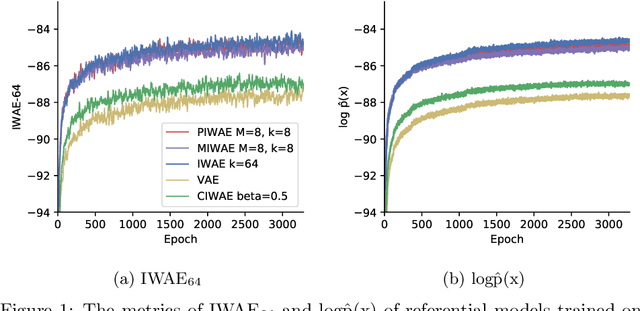
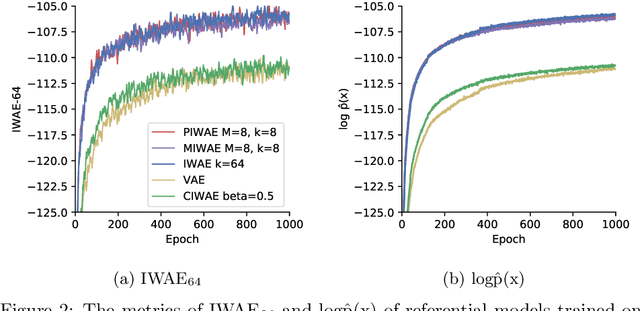

Abstract:This report explains, implements and extends the works presented in "Tighter Variational Bounds are Not Necessarily Better" (T Rainforth et al., 2018). We provide theoretical and empirical evidence that increasing the number of importance samples $K$ in the importance weighted autoencoder (IWAE) (Burda et al., 2016) degrades the signal-to-noise ratio (SNR) of the gradient estimator in the inference network and thereby affecting the full learning process. In other words, even though increasing $K$ decreases the standard deviation of the gradients, it also reduces the magnitude of the true gradient faster, thereby increasing the relative variance of the gradient updates. Extensive experiments are performed to understand the importance of $K$. These experiments suggest that tighter variational bounds are beneficial for the generative network, whereas looser bounds are preferable for the inference network. With these insights, three methods are implemented and studied: the partially importance weighted autoencoder (PIWAE), the multiply importance weighted autoencoder (MIWAE) and the combination importance weighted autoencoder (CIWAE). Each of these three methods entails IWAE as a special case but employs the importance weights in different ways to ensure a higher SNR of the gradient estimators. In our research study and analysis, the efficacy of these algorithms is tested on multiple datasets such as MNIST and Omniglot. Finally, we demonstrate that the three presented IWAE variations are able to generate approximate posterior distributions that are much closer to the true posterior distribution than for the IWAE, while matching the performance of the IWAE generative network or potentially outperforming it in the case of PIWAE.
Unsupervised Change Detection of Extreme Events Using ML On-Board
Nov 04, 2021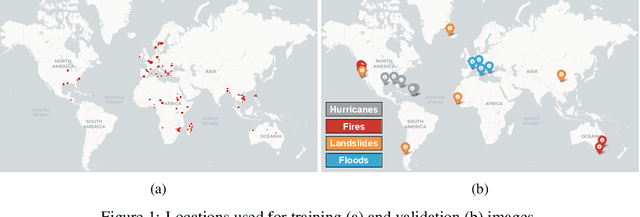

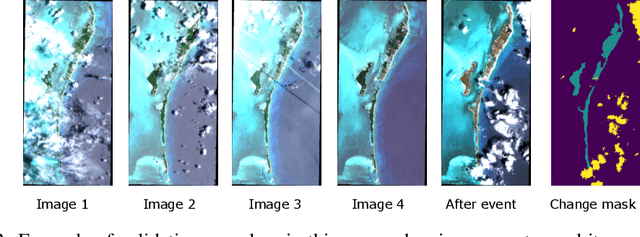

Abstract:In this paper, we introduce RaVAEn, a lightweight, unsupervised approach for change detection in satellite data based on Variational Auto-Encoders (VAEs) with the specific purpose of on-board deployment. Applications such as disaster management enormously benefit from the rapid availability of satellite observations. Traditionally, data analysis is performed on the ground after all data is transferred - downlinked - to a ground station. Constraint on the downlink capabilities therefore affects any downstream application. In contrast, RaVAEn pre-processes the sampled data directly on the satellite and flags changed areas to prioritise for downlink, shortening the response time. We verified the efficacy of our system on a dataset composed of time series of catastrophic events - which we plan to release alongside this publication - demonstrating that RaVAEn outperforms pixel-wise baselines. Finally we tested our approach on resource-limited hardware for assessing computational and memory limitations.
Deep Active Learning in Remote Sensing for data efficient Change Detection
Aug 25, 2020



Abstract:We investigate active learning in the context of deep neural network models for change detection and map updating. Active learning is a natural choice for a number of remote sensing tasks, including the detection of local surface changes: changes are on the one hand rare and on the other hand their appearance is varied and diffuse, making it hard to collect a representative training set in advance. In the active learning setting, one starts from a minimal set of training examples and progressively chooses informative samples that are annotated by a user and added to the training set. Hence, a core component of an active learning system is a mechanism to estimate model uncertainty, which is then used to pick uncertain, informative samples. We study different mechanisms to capture and quantify this uncertainty when working with deep networks, based on the variance or entropy across explicit or implicit model ensembles. We show that active learning successfully finds highly informative samples and automatically balances the training distribution, and reaches the same performance as a model supervised with a large, pre-annotated training set, with $\approx$99% fewer annotated samples.
The Myths of Our Time: Fake News
Aug 05, 2019



Abstract:While the purpose of most fake news is misinformation and political propaganda, our team sees it as a new type of myth that is created by people in the age of internet identities and artificial intelligence. Seeking insights on the fear and desire hidden underneath these modified or generated stories, we use machine learning methods to generate fake articles and present them in the form of an online news blog. This paper aims to share the details of our pipeline and the techniques used for full generation of fake news, from dataset collection to presentation as a media art project on the internet.
* 5 pages, 5 figures, in proceedings of International Symposium on Electronic Art 2019 (ISEA)
Fast and accurate object detection in high resolution 4K and 8K video using GPUs
Oct 24, 2018



Abstract:Machine learning has celebrated a lot of achievements on computer vision tasks such as object detection, but the traditionally used models work with relatively low resolution images. The resolution of recording devices is gradually increasing and there is a rising need for new methods of processing high resolution data. We propose an attention pipeline method which uses two staged evaluation of each image or video frame under rough and refined resolution to limit the total number of necessary evaluations. For both stages, we make use of the fast object detection model YOLO v2. We have implemented our model in code, which distributes the work across GPUs. We maintain high accuracy while reaching the average performance of 3-6 fps on 4K video and 2 fps on 8K video.
Estimating Bicycle Route Attractivity from Image Data
Jun 27, 2018



Abstract:This master thesis focuses on practical application of Convolutional Neural Network models on the task of road labeling with bike attractivity score. We start with an abstraction of real world locations into nodes and scored edges in partially annotated dataset. We enhance information available about each edge with photographic data from Google Street View service and with additional neighborhood information from Open Street Map database. We teach a model on this enhanced dataset and experiment with ImageNet Large Scale Visual Recognition Competition. We try different dataset enhancing techniques as well as various model architectures to improve road scoring. We also make use of transfer learning to use features from a task with rich dataset of ImageNet into our task with smaller number of images, to prevent model overfitting.
 Add to Chrome
Add to Chrome Add to Firefox
Add to Firefox Add to Edge
Add to Edge